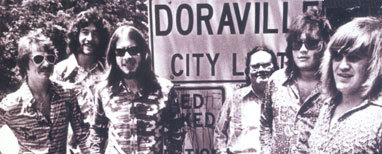|
The
group went to work on "Back up Against the Wall," their
second album for MCA/Decca. They kept working hard, spending a
lot of time in the studio. For a time, Hammond and Daughtry lived
upstairs above Studio One. It was here that ARS first crossed
paths with Lynyrd Skynyrd, who rolled in one night raising a ruckus.
Producer Al Kooper worked at Studio One during the day, and then
ARS would come in and work at night
The
second album was released in 1973. With a number of quality songs,
the album got the group more notice but did not produce a breakthrough
single. At this time, the group got out of the studio to do their
first live shows and went on tour to support the album and to
expand upon their studio skills in concert.
 The
11 songs on "Backup Against the Wall" offer a mix of up-tempo
tunes and ballads-an approach that would become a cornerstone
of the group's future success. The pace overall is slower and
more restrained than where the group would go with future albums.
But it is a beautiful timepiece of a group of talented musicians
playing quality songs and working together to establish their
collective sound. There's a mix of tempos, both between songs
and within individual tunes, which the band would refine on future
records. The
11 songs on "Backup Against the Wall" offer a mix of up-tempo
tunes and ballads-an approach that would become a cornerstone
of the group's future success. The pace overall is slower and
more restrained than where the group would go with future albums.
But it is a beautiful timepiece of a group of talented musicians
playing quality songs and working together to establish their
collective sound. There's a mix of tempos, both between songs
and within individual tunes, which the band would refine on future
records.
After
this album, the band decided to leave MCA/Decca for Polydor. They
also started to establish a reputation in the Atlanta area for
doing great live shows by the time they went back into Studio
One to work on their next album.
With
"Third Annual Pipe Dream," Songs Begin to Hit the Charts
"Third
Annual Pipe Dream," ARS's third album, presented a more accessible
ARS-a punched up but smoother sound, a variety of types of songs
and a unique sound that could have both pop and rock appeal. It
climbed to number 74 on the U.S. charts and gave the group their
first regional hit, Doraville, which reached the top 40. Angel
was also released as a single and reached number 75 as another
regional hit-but overall the quality collection of songs didn't
generate the level of recognition it deserved.
The
10 songs on "Third Annual Pipe Dream," including 8 written by
Buddy Buie in conjunction with other band members, show ARS to
have become both tighter in their playing and more polished in
their song presentation. The band's pop oriented songwriting and
diverse musical stylings-characteristics that would distinguish
them from other Southern Rock bands-are displayed to great effect
and show a band coming into their own.
Still
Building a National Reputation
ARS's
unique brand of music was developing a regional following, but
they had yet to reach a national audience. They continued to play
live shows, working to solidify their identity and carve out their
niche.
At the time, the Allman Brothers had fallen on hard times and
Lynyrd Skynyrd was leading the charge of guitar based Southern
Rock. While ARS shared some musical approaches with these contemporaries,
their background as musicians-not performers-and more pop oriented
songwriting put them in a unique position along with but not truly
a part of the Southern Rock scene.
They
rocked, but they also dabbled with country and blues-all with
more of a pop feel than some of their contemporaries. Their songwriting
continued to improve. Their musicianship was tighter than ever.
ARS tried to be true to themselves and fit into the musical landscape,
a challenge they described in the song Boogie Smoogie: "We like
reggae, we dig country, classical music's a gas, we play the blues
in three quarter time but they don't want to hear that jazz-they
want to boogie.".
ARS
returned to Studio One in 1974 to work on their next album. They
built on the polished production of the previous album while working
out a set of songs that were tighter and better than what they'd
done before. As always, new songs were written on acoustic guitar
or piano, and brought into the studio before being done in concert.
In the studio, the band would approach their own material just
like it was someone else's-taking chord charts and doing multiple
takes to try different approaches. It was a style that stressed
discipline over spontaneity, and over 4-5 years helped ARS to
develop their unique sound, which was now coming together.
|

